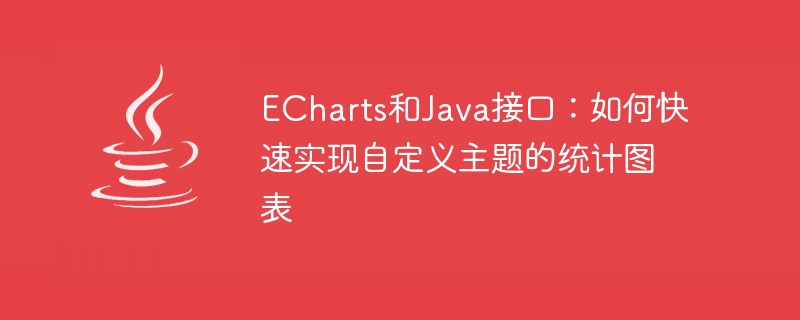

ECharts and Java interface: How to quickly implement statistical charts with custom themes
Abstract: ECharts is a powerful data visualization library that helps us be fast and flexible Draw various statistical charts. This article will introduce how to use ECharts and Java interfaces in Java to implement custom theme statistical charts, and provide specific code examples.
Introduction:
Statistical charts are one of the commonly used tools in data analysis and visualization. In the past, it usually took a lot of time and effort to implement a beautiful, customized statistical chart. However, now with ECharts, a powerful open source library, we can easily create a variety of statistical charts in web pages.
ECharts is a Javascript-based chart drawing library developed by Baidu, with powerful functions and flexible usage. We can configure various properties and styles of the chart through the ECharts API, such as title, axis, legend, etc. In addition, ECharts also supports custom themes, allowing us to customize unique chart styles according to our needs.
In this article, we will use the Java programming language and the Java interface of ECharts to demonstrate how to quickly implement statistical charts of custom themes.
Step One: Preparation
First, we need to introduce the Java interface of ECharts into the Java project so that we can call the functions of ECharts in Java. We can add the following dependencies in Maven's pom.xml file:
<dependency>
<groupId>com.github.abel533</groupId>
<artifactId>echarts</artifactId>
<version>4.6.0</version>
</dependency>In addition, we also need to prepare some demonstration data to show the functions and styles of statistical charts.
Step 2: Create a chart object
In Java code, we can use the Java interface of ECharts to create a chart object. First, we need to create an echarts.ECharts object and then set the basic properties of the chart.
The following is a sample code to create a histogram:
import echarts.ECharts;
import echarts.option.Options;
import echarts.series.Bar;
ECharts echarts = new ECharts();
Options options = new Options();
Bar bar = new Bar();
bar.setName("销量");
bar.setData(Arrays.asList(120, 200, 150, 80, 70));
options.series(bar);
echarts.setOption(options);In the above code, we first create a ECharts object and create a Options object to set the properties of the chart. Then, we created a histogram object and set the name and data of the histogram. Finally, we add the histogram object to the chart's Options object.
Step 3: Set up a custom theme
To set up a custom theme, we first need to create a theme object that contains our custom styles. The theme object is configured using JSON format, where we can define the style, color, font, etc. of the chart.
The following is a sample code to set a custom theme:
import echarts.theme.Theme;
Theme theme = new Theme();
theme.setTextStyle("fontSize", 16);
theme.setBackgroundColor("#f5f5f5");
theme.setColor(Arrays.asList("#4572a7", "#aa4643", "#89a54e", "#80699b", "#3d96ae");
echarts.setTheme(theme);In the above code, we create a Theme object and set some basic themes style. For example, we set the font size of the text to 16, the background color to gray, and the series colors to 5.
Step 4: Generate charts
After we create the chart object and set the custom theme, we can generate the chart as an image or HTML code. The Java interface of ECharts provides corresponding methods to implement this function.
The following is a sample code that generates a chart into HTML code:
import echarts.render.EChartsRenderer; String chartHtml = EChartsRenderer.render(echarts);
In the above code, we use the render method of EChartsRenderer Convert the chart object into HTML code and store it in the chartHtml variable.
Conclusion:
By using the Java interface of ECharts, we can quickly and flexibly implement various statistical charts in Java projects. By setting a custom theme, we can also customize the style and style of the chart according to our needs. This article provides specific code examples, hoping to help readers understand and use ECharts and Java interfaces.
The above is the detailed content of ECharts and Java interface: How to quickly implement statistical charts of custom themes. For more information, please follow other related articles on the PHP Chinese website!
